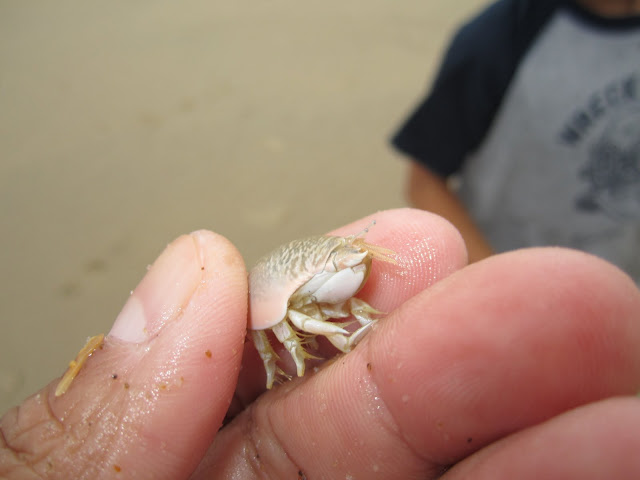Tiny sand crabs are among the strangest of the shoreline creatures. Often found wiggling into sand on the water's edge, these little plankton eating creatures are actually quite amazing.
These mini-crabs don't have too much going for them. They can only walk backwards...yes, that's right. Backwards only. The sweet little legs of theirs don't have claws. Unlike most crabs which move in all directions, these darlings live life in one direction.
The shifting sand of the waters edge is home to these creatures and they spend life browsing the ever moving waves and sand for bits of plankton with their tiny feather like antennae. They sweep so quickly, in fact, that they can gather multiple feather-fulls of food with each passing wave.
By burrowing quickly and often, they can maintain balance in the rushing water. But if dislodged from the sand, they have the ability to tread water using their tiny back legs, an ability quite rare for a crustaceans.
These creatures might seem quite useless, but their filter feeding style is an important signal to dangerous toxins that often enter the ocean water through pollution and other contamination. Since sand crabs live at the waters edge, they are one of the first to ingest land-bound toxicity.
One naturally occurring toxin, Domoic acid, causes serious amnesic poisoning in higher animals, and occasionally in humans. This acid is a nerve toxin produced by microscopic, single celled plants that live in the ocean. As filtering feeders, sand crabs ingest the toxin and it progresses up the food chain. The amount of Domoic acid in the sand crabs flesh can indicate the amount of toxin in the water. (fact source found here)
Another interesting fact about these small creatures is their use in neurological studies conducted in laboratories. The tail of a sand crab has the largest sensory neurons found in any animal. For being the size of a bottle top, these little creatures pack a powerful punch.
In addition to their ultra sensitive tales, female sand crabs have the amazing ability to produce as many as 45,000 eggs and she can carry them on her abdomen for 30 days until the eggs hatch. The larvae live as drifting plankton for 2-4 months and water currents can carry them long distances from their origin. Sand crabs can reproduce during their first year of life and live for approximately 2-3 years.


No comments:
Post a Comment